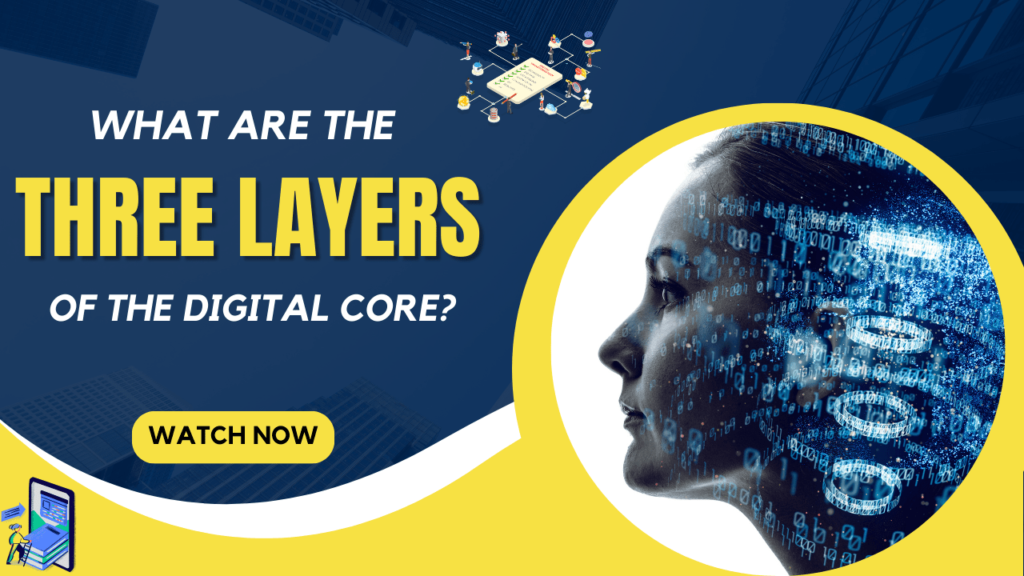
As data becomes more and more valuable, companies need to manage and control their data efficiently in order to stay competitive in the disruptive digital future.
The Digital Core is a crucial part of future digital companies. This complex effort involves many layers across different business areas – understanding technology, managing integration, leading cultural change, driving business results. It requires a strong vision and execution plan to develop a successful digital transformation strategy.
What is the Digital Core?
The Digital Core is a robust digital foundation that connects the company’s critical business processes and data streams, enabling stakeholders to seamlessly interact with digital systems and collaborate with each other. The goal is to become a real-time business.
The Digital Core is the enterprise’s integrated set of vital business processes and data, with convergence of core transactions and analytics. Working together, this allows for instant visibility and insight, resulting in real-time decision making for key business processes.
Having a digital core is not just adding complex technical systems to existing processes, but redefining processes to fully leverage emerging technologies.
What is the rationale for a Digital Core?
A robust and dynamic digital core is vital for successfully executing digital transformation, modernizing business systems, and achieving unparalleled levels of operational speed and flexibility. In truly digital or “live” businesses, massive quantities of data are processed and analyzed instantaneously, while advanced learning and predictive analysis technologies provide stakeholders real-time insights.
Management dashboards and unified communications systems enable people to easily manage systems and interact with each other, while increasingly smarter technology allows for rapid automation of routine processes and decision-making based on real-time insights.
While most CEOs agree that digital transformation is critical, 70% of relevant initiatives will fail, per McKinsey. The issue is not their people, processes, and tools. Rather, they are missing a critical component of the overall digital puzzle: A performance infrastructure that supports the people, processes, and tools enabling and sustaining digital transformation.
The Fourth Industrial Revolution has created constant changes in modern life, applying digital technology innovations’ core values. Specifically, digital transformation (DT) has also gradually gained more attention from businesses and individuals, despite having crept into business operational processes since computers became popular in the 1990s.
However, DT has marked a dramatic breakthrough as it matured into a globally hot topic. This term demonstrates tremendous impact on the future of business. DT’s critical elements – data digitization, process digitization, and model digitization – have fully shown the improvement tasks for companies to capitalize on future opportunities. They are also essential pillars in multilayer DT systems, forming seamless data, technology, and people.
Why is a digital transformation strategy crucial?
Companies frequently depend too heavily on technology as the core of their transformation efforts, especially when marketers and analysts promote the newest, trendiest solution as the magic bullet to solve persistent problems.
Though this can sometimes be true, it’s actually the strategy, not the technology itself, that propels digital transformation, according to a global survey done by MIT Sloan Management Review and Deloitte. Without strategic preparation to introduce change in an organization, even the best technologies may fail to provide expected benefits.
The most prominent cautionary example of this is the BBC’s Digital Media Initiative (DMI). It was the cornerstone of the BBC’s digital transformation effort, promising to streamline broadcasting operations through adopting a tapeless, fully digital production workflow; unify video, audio, and still image archives using media asset management; and accelerate new program development through an online storyboarding system.
After receiving £81 million in funding and nearly 2 years of development, the contract with the supplier was terminated due to increasing costs, delays, and technical problems. The BBC brought the project in-house with a revised budget of £133.6 million.
After an additional 2 years of struggle, DMI was finally cancelled, resulting in total losses of £125.9 million (over $150 million) for the BBC.
What went wrong? To find out, the National Audit Office (NAO) supported by PwC (PricewaterhouseCoopers) launched an investigation that eventually evaluated DMI as a “complete failure.”
The main identified reasons were: weak governance and quality assurance, lack of business engagement, failure to agree on project management methodology, and not having a plan to extend the transformational effort to business operations.
In other words, the digital transformation strategy was not developed and executed effectively. It’s estimated that in 2018, companies globally spent over $1.3 trillion on digital transformation projects. Out of this sum, $900 billion did not yield expected results or was terminated before completion.
The difference between successful and failed projects? In most cases, it was a solid digital transformation strategy established at the start of the project and updated as it progressed towards completion.
Terminology related to digital transformation & its associated perspectives
Digital transformation is a crucial procedure for traditional business models to keep up with new technologies and times. Implementing DT suitable for each business will boost its market competitiveness, thereby raising revenue while streamlining operations, enriching corporate culture and human capital. A complete DT framework has three layers: data, processes, and business models.
The data layer requires digitizing information sources using technologies for easy management. A company will implement transformative strategies for operations built on transformed data in the process and model layers.
Firms can adapt their models to suit long-term orientation and expand corporate culture extensively. They can implement the layers stepwise or simultaneously if fitting business needs and specific short and long-term transformation plans.
Data digitization
Data digitization means shifting from paper to digital formats and storing them in computerized management systems. These systems use technologies to store data intelligently, facilitating more manageable and faster retrieval. Thus, data becomes more proactive and brings substantial value to the business.
Digitization streamlines workflows while ensuring systematic, complete data sources, constructing comprehensive digital infrastructure. It is the kernel of digital transformation, forming the base for other layers. Data digitization now is an optimal long-term solution ensuring data integrity and security while significantly lowering costs.
Moreover, database management systems are critical archives maximizing data access and utilization efficiency. MySQL is a popular open-source DMS with useful features ensuring speed and safety even for large ecommerce data. Alongside others like SQL Server, Oracle, PostgreSQL, MySQL meets most storage, security and safety needs.
These advantages have made MySQL appreciated by experts across complex tech industries.
Process and business model digitization (PMD)
Building on the digital data core, PMD forms a wider layer encompassing it. This complex category has various forms based on operations’ ways and goals. PMD refers to transformation relying on digital infrastructure and data to form a digital platform.
Completing digitization requires analyzing issues in processes and models. This provides the right direction and strategy for transformation decisions. PMD helps businesses meet DT needs: customer connections, appropriate tech initiatives, and optimizing human resources over time. Firms should combine digital solutions to create customer value and operating models.
Many now use CRM or ERP platforms to optimize processes in time and resources, like Zoho, Microsoft Dynamics, and Salesforce CRM. These support sales continuity and disentangle manual processes and data issues. CRM and ERP effectively assist sales targeting and streamline complex manual processes and data control/preservation.
Digital transformation (DT) is the broadest category, the complete model bringing businesses closer to the digital economy. DT represents fully digitizing data and processes, business models. Its core goal is human-centricity while combining corporate culture with customer centricity. DT sets macro goals of human direction in strategies, culture, tech adaptation.
Generally, DT barriers arise when companies ignore comprehensive data digitization while focusing only on broader process/model digitization. Without thorough initial steps, transformation lacks impact.
Additionally, preliminary time and budget estimates become challenges over set periods. Many cannot achieve expected results. However, despite current challenges (like COVID-19), digital transformation provides extensive support via data systems and digital platforms, eliminating distances and easily connecting anytime.
Is ecommerce the ultimate goal of digital transformation?

The digital transformation process has improved efficiency and revenue for many B2C and B2B businesses. Specifically, ecommerce has seen impressive growth since 2017 and is the most common example. B2C companies have also developed a stronger ecommerce presence than ever before.
Meanwhile, B2B models are focusing more on transforming production, distribution, and other processes by gradually shifting them online to adapt to the flexibility and speed of the 4.0 supply chain.
Up to this point, ecommerce can be viewed as the full realization of digital transformation. Ecommerce channels can continuously update information quickly while optimizing UI/UX to deliver an excellent user experience, customer experience, and as a result, increased sales.
These are also the requirements for digitizing markets and perfecting business operating systems. Depending on the digital transformation goals, a company will stop at the stage that best fits its business model. Some businesses only need to digitize data for easier operations.
However, from a broader perspective, almost all companies adopt an ecommerce system to independently control their business and connect directly with customers, partners, and come closer to digital transformation outcomes. These goals also represent the straightforward development orientation of most retailers today. They devote substantial resources to developing their ecommerce channels to expand their business scale.
For example, The Coffee House is a case study of impressive digital transformation outcomes in Vietnam’s F&B industry. The brand has implemented an ordering app for more intensive data management and operations. This app was initially built to increase the convenience of their loyalty program and improve customer service quality.
However, now this sales channel has grown beyond that and has become a core business channel seamlessly integrated with the brand’s existing offline stores.
The TCH app aims to connect and interact directly with customers based on a D2C model, allowing app users to create accounts to earn points and order quickly. These features allow the brand to easily access customer data and shopping habits. In-depth data analysis will contribute to new product strategies or menu changes to better suit customers’ tastes.
Digital transformation is a long-term journey that requires a detailed and comprehensive strategy while meeting time and budget constraints and matching current business capabilities.
Digitization/digitalization layers also need to fully play their role in digital platforms, enabling complete and efficient transformation. Comprehensive ecommerce system considerations are also required for current market supply chains.
While ecommerce will be the most agile digital transformation driver, it’s important to implement a strategy with the right priorities for the current situation to maximize impact.
Read Also: What Are 7 Key Metrics That All Digital Marketers Should Measure?
Conclusion
Digital transformation provides companies with a chance to be more successful than before. They can get ahead of the competition by adapting to the changing digital world. But each company is unique, with its own business needs and challenges to overcome as they work towards digital maturity.
Having an experienced partner who grasps these issues and knows how to address them will make the process much simpler.
